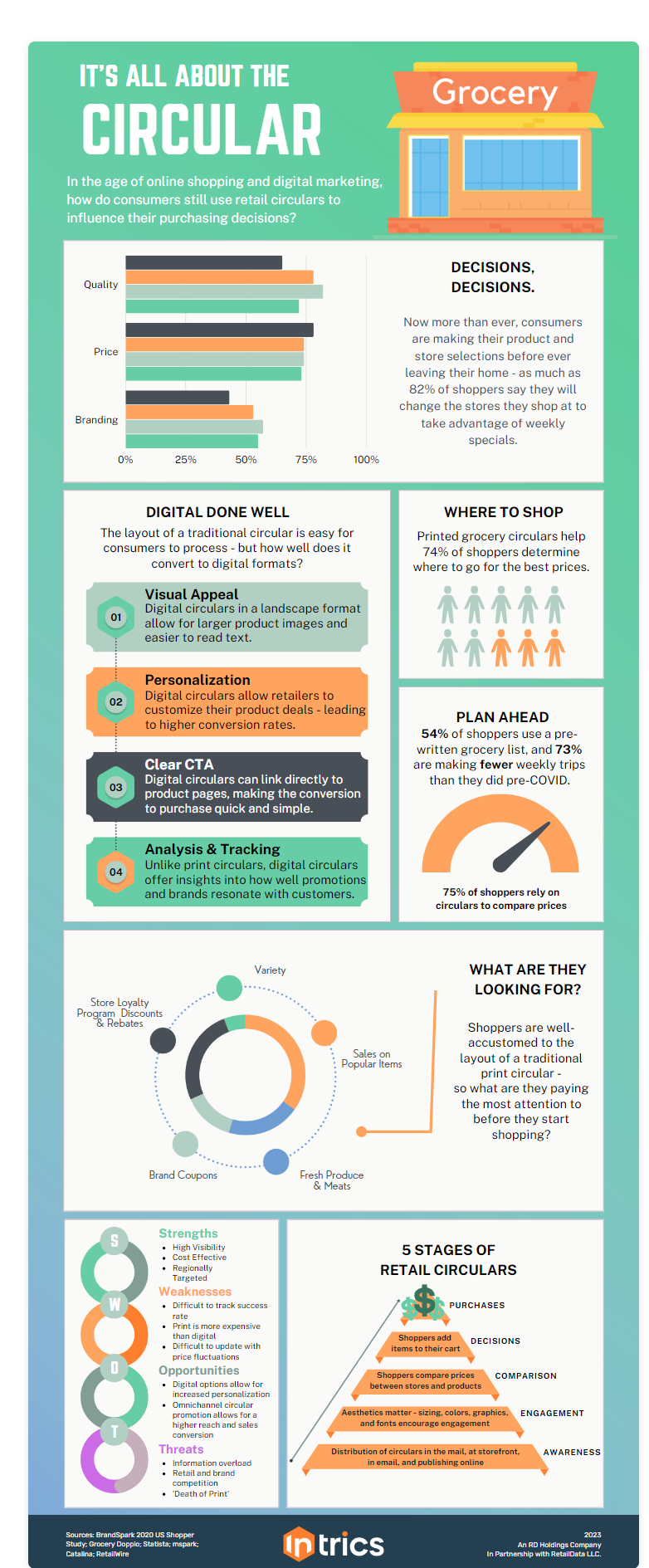![[Blog Banner Image of Young People Looking at their phones. A cellphone with a megaphone blasting advertisements, gifts, and social media icons is in the background] Text Reads: Are Grocery Circular Relevant in the Digital Age](https://intrics.io/wp-content/uploads/2023/01/How-to-keep-your-circular-relevant-in-the-digital-age-2.png)
Retail circulars have been an effective tool for retailers to promote their products and services for decades. They are an excellent way for brands to reach their target customers and engage them with their products. Yet, in the age of online shopping and digital marketing, do consumers still use retail circulars to influence their purchasing decisions? Let’s explore this question further.
The Rise of Online Shopping
In recent years, we’ve seen a surge in the popularity of online shopping. Consumers can now shop from the comfort of their homes, which has changed how they shop and research products. Many people no longer rely on traditional media like newspapers or magazines to stay informed about sales or promotional offers. Instead, they rely more heavily on digital sources such as email newsletters and social media posts. An overwhelming number of consumers use both print (76%) and online (71%) channels to compare prices, yet printed circulars drive an 11% purchase intent compared to 4% digital-only. Certainly, digital and print circulars work best synergistically to boost conversion rates by 28% versus print alone. (Source: mspark)
The Impact on Retail Circulars
Despite this shift towards digital media, evidence suggests that consumers still use retail circulars to inform their purchasing decisions. According to research from the National Retail Federation, 87% of Americans use retail circulars when shopping for online and in-store items. Traditionally, the Sunday newspaper included print circulars, but today, less than 1-in-5 American households still need a printed Sunday paper. The COVID-19 pandemic has only accelerated the retail shift toward the digital age, making it increasingly difficult for retailers to publish and distribute their circulars. In a sea of online advertisements, emails, apps, and text messaging coupons, consumers are raising their expectations for what they want from their retailers. Ultimately, retailers should create meaningful and personalized promotions to draw in consumers.
Moreover, while many shoppers still prefer print over digital when receiving promotional materials regarding sales or discounts, online deals are also a critical channel for marketers. In fact, 82% of shoppers say they are willing to change their stores to take advantage of weekly specials – 54% of consumers look for online deals when choosing where to buy their groceries for the week. The high usage rates indicate that despite the rise in online shopping, retail circulars remain a vital part of the consumer buying process.
Why Do Consumers Still Use Retail Circulars?
So why do so many consumers continue to use retail circulars? For one thing, traditional forms of advertising are still effective when reaching specific demographics who may not be particularly tech-savvy or active on social media platforms. Furthermore, some studies suggest that physical copies of ads (such as those found in newspapers) are often more effective than digital versions due to their tactile nature; they are easier to track and reference when needed. In a study by Vericast, they found that printed circulars take 21% less cognitive effort to process than digital marketing, making them ideal for consumers with short attention spans and too much information.
Conclusion
On the whole, despite its decline over recent years, print media, such as retail circulars, still play an essential role in influencing consumer purchasing decisions. The fact that so many still use print ads indicates that marketers should pay attention to these formats when creating promotions. For marketers looking for ways to reach potential customers effectively, investing in digital and print campaigns is vital to maximizing reach and engagement with your target audience. Although digital marketing has undoubtedly risen in prominence over recent years, it is clear that traditional forms of advertising—like print media—are still relevant today when used correctly and strategically within a larger marketing mix strategy.

Intrics provides insights and clarity by analyzing over 100 million price changes weekly from top retailers in every market of the United States. By considering national brands and private-label alike and linking disparate SKUs and descriptions to a single UPC, Intrics provides product-level indexes in your market. This allows you to be the first to react by quickly understanding changes to product prices, whether your competitors are absorbing or forwarding increased costs to consumers, and how your prices and price changes compare to theirs.
